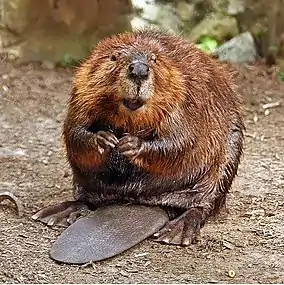Aquatic invasive species in Canada
Canadian aquatic invasive species are all forms of life that traditionally has not been native to Canada's waterways. In Eastern Canada, non-native plant and animal species are a concern to biologists. Bringing non-native species such as invasive fishes into Canada can damage the environment and ecosystem by repressing native species due to food competition or preying. Invasive fishes enter the fresh waters of Canada in several ways including drifting, deliberate introduction, accidental release, experimental purposes and, most commonly, through the attachment on international boat hulls.
| Part of a series on |
| Wildlife of Canada |
|---|
 |
Species at risk
Of the fish and other marine life under threat in Canada the primary threat is loss of habitat and degradation, followed by alien invasive species. Fifteen invasive species of fish and two invasive species of plant are reported to affect native listed wildlife. The two most common of them are the brown bullhead (Ameiurus nebulosus) and the pumpkinseed (Lepomis gibbosus).[1]
Sea lampreys and the collapse of the trout fisheries in the 1940s

Between the early 1940s and the 1960s the lake trout catch from Lake Huron and Lake Superior dropped from about 6.8 million kg (15 million lbs) to 136,077 kg (300,000 lbs), about two percent of its former level, largely attributed to the introduction of sea lampreys. The Sea Lamprey made its way into the Canadian ocean through a canal system that was initially built by man in the early 1830s. Their physical structure is built to attack and feed on other fishes with different species. Their mouth has a suction that sucks and attach to other fishes, then use then use its blade sharp teeth and tongue to puncture holes into the body of other fishes such as: salmon brown trout, whiten fish and yellow fish. The Sea lamprey feeds on the blood of other fish species. After puncturing the body of a different fish species; the Sea Lamprey then leave the fish with an open wound which in turn causes them to bleed till death. Rarely a different fish survive a Lamprey puncture.[2]
Zebra mussels in the (Great Lakes)
_Shells_-_Long_Point%252C_Ontario_2013-04-26_(02).jpg.webp)
Another example of the migration of non-native species is Dreissena polymorpha, common name Zebra Mussel, originating in Asian waters. They first appeared in North-America in 1988 in Lake St Clair. The Zebra mussels are (filter feeders) and fully grown mussels have the potential of filtering up to a liter (1 quart) of water per day. With the large population of mussels found in Canadian waters, this means the waters are being filtered each day, which causes an unpleasant habitat for native fish species that rely on algae for food. The filtering habit of the mussels increases the clarity of the water and invites direct UV rays into the water that damage other fish species and laid eggs while forcing fishes like the Walleye, that are sensitive to sunlight, to seek new habitats.
Sea squirts
Several species of non-native ascidians with known negative impacts to aquaculture operations have been introduced and established to both the Pacific and Atlantic coasts of Canada. These non-native sea squirt species include: Ascidiella aspersa (the European sea squirt), Botrylloides violaceus (the violet tunicate), Botryllus schlosseri (the golden star tunicate), Didemnum vexillum (the pancake batter tunicate), Diplosoma listerianum, and Styela clava (the stalked tunicate).[3][4] Ciona intestinalis is generally considered a cryptogenic species that is invading eastern Canada, including Newfoundland.[5]
References
- Dextrase, Alan; Mandrak, Nicholas (2006-01-01). "Impacts of Alien Invasive Species on Freshwater Fauna at Risk in Canada". Biological Invasions. Springer Netherlands. 8 (1): 13–24. doi:10.1007/s10530-005-0232-2. ISSN 1387-3547.
- "Aquatic Invasive Species".
- Ma, Kevin; Simard, Nathalie; Stewart-Clark, Sarah; Bernier, Renée; Nadeau, Madeleine; Willis, Jessica (2016). "Early detection of the non-indigenous colonial ascidian Diplosoma listerianum in eastern Canada and its implications for monitoring". Management of Biological Invasions. 7 (4): 365–374. doi:10.3391/mbi.2016.7.4.06.
- Ma, Kevin (2019). "Morphological identification of two invading ascidians: new records of Ascidiella aspersa (Müller, 1776) from Nova Scotia and Diplosoma listerianum (Milne-Edwards, 1841) from New Brunswick and Quebec". BioInvasions Records. 8 (1): 50–64. doi:10.3391/bir.2019.8.1.06.
- Sargent, Philip; Wells, Terri; Matheson, Kyle; McKenzie, Cynthia; Deibel, Don (2013). "First record of vase tunicate, Ciona intestinalis (Linnaeus, 1767) in coastal Newfoundland waters". BioInvasions Records. 2 (2): 89–98. doi:10.3391/bir.2013.2.2.01.
External links
- A Canadian Action Plan to Address the Threat of Aquatic Invasive Species by the Canadian Council of Fisheries and Aquaculture Ministers Aquatic Invasive Species Task Group
- welcome to the Species at Risk Public Registry by Species at Risk Public Registry
- https://web.archive.org/web/20100527124727/http://www.nationalatlas.gov/articles/biology/a_zm.html
